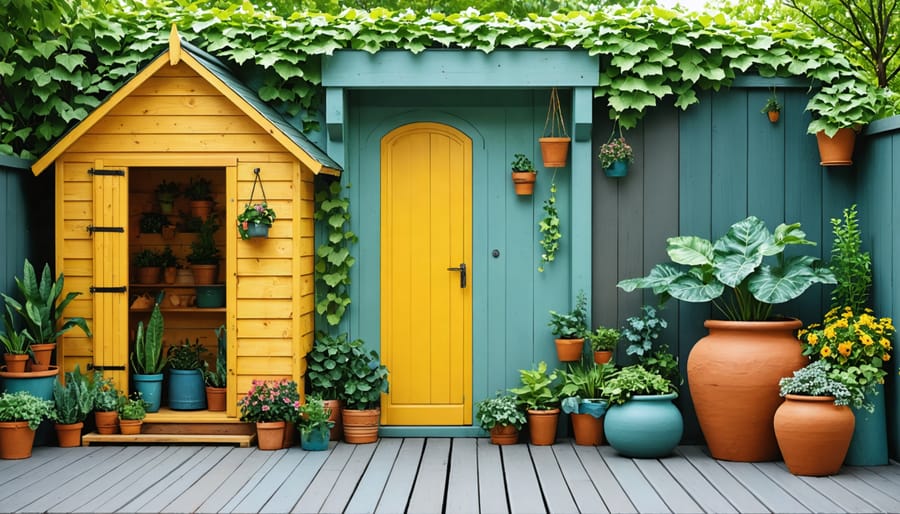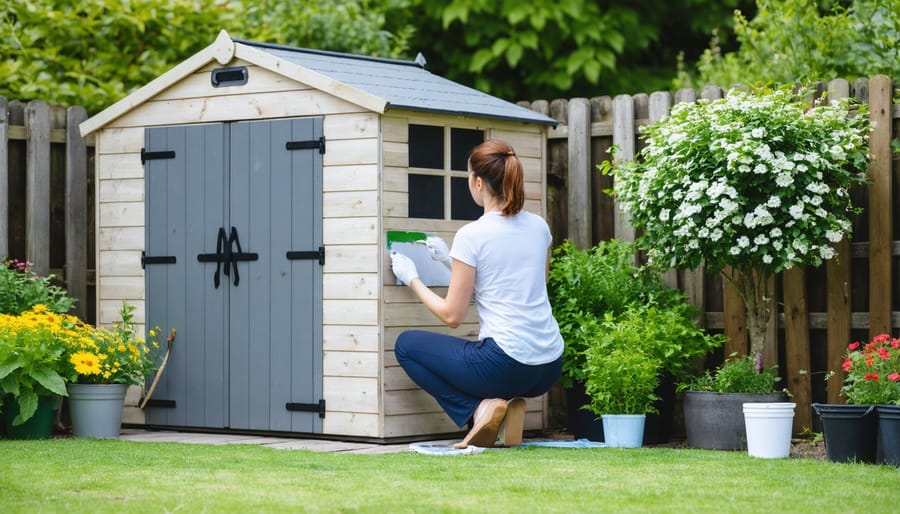Transform Your Outdoor Space with Earth-Safe Paint That Actually Lasts

Transform your outdoor structures into sustainable outdoor spaces with eco-friendly paint that protects both your property and the environment. Modern water-based acrylic formulations now rival traditional paints in durability while releasing 75% fewer volatile organic compounds (VOCs). Natural mineral-based and milk-based paints offer completely biodegradable alternatives that weather beautifully, creating a distinctive matte finish that enhances wood grain and masonry textures. These earth-conscious options not only safeguard your family’s health but also maintain their vibrant appearance for up to 10 years with proper application. Beyond environmental benefits, eco-friendly paints provide superior breathability, reducing moisture buildup and preventing common issues like peeling and mildew growth that plague conventional oil-based products.
What Makes Outdoor Paint Eco-Friendly?
Low-VOC vs Zero-VOC Options
When choosing eco-friendly outdoor paint, understanding VOC levels is crucial for both environmental impact and health considerations. Low-VOC paints contain less than 50 grams of volatile organic compounds per liter, significantly reducing harmful emissions compared to traditional paints. These options offer a good balance between performance and environmental responsibility, making them popular for outdoor projects.
Zero-VOC paints take environmental protection a step further, containing less than 5 grams of VOCs per liter. While slightly more expensive, these paints are ideal for environmentally conscious homeowners who want to minimize their carbon footprint. They’re particularly beneficial for those with sensitivities to chemical emissions or families with young children.
Both options provide excellent coverage and durability for outdoor applications. Low-VOC paints typically offer a wider color selection and may be easier to find at local retailers. Zero-VOC alternatives, though more specialized, have improved significantly in recent years, matching their conventional counterparts in quality and finish while maintaining their eco-friendly benefits.
Remember that even zero-VOC base paints may contain small amounts of VOCs when tinted, so always check the final VOC content after color mixing.

Natural and Sustainable Ingredients
Modern eco-friendly outdoor paints utilize natural ingredients that minimize environmental impact while delivering excellent protection for your outdoor structures. These paints typically feature plant-based oils like linseed, hemp, and sunflower as binding agents, replacing traditional petroleum-based components. Natural mineral pigments, including iron oxide, ochre, and umber, provide rich, lasting colors without synthetic dyes.
Clay and chalk serve as natural fillers, while milk protein (casein) acts as a sustainable binding agent in some formulations. Many eco-friendly paints incorporate natural resins from trees, such as pine and citrus, which offer natural water resistance and durability. These ingredients are often sourced from renewable resources and sustainable farming practices.
What makes these paints particularly appealing is their low VOC (Volatile Organic Compounds) content. Instead of harsh chemicals, manufacturers use natural preservatives like citrus extracts and essential oils to maintain product stability. Even the thickening agents come from plant-based sources like cellulose and natural gums, ensuring every component aligns with environmental consciousness while maintaining high performance standards.
Best Applications for Eco-Friendly Outdoor Paint
Wood Structures and Garden Features
When it comes to protecting your wooden outdoor structures, choosing the right eco-friendly paint is crucial for both durability and environmental responsibility. Start by thoroughly cleaning and sanding your wooden surfaces to ensure optimal paint adhesion. For sheds and fences, opt for water-based exterior paints that contain low or zero VOCs (Volatile Organic Compounds).
If you’re refreshing your eco-friendly outdoor furniture, consider using natural oils like linseed or tung oil as alternatives to traditional paint. These options penetrate the wood deeply while maintaining its natural beauty and grain patterns.
Apply your chosen paint or finish in thin, even coats using a high-quality brush or roller. Work in the direction of the wood grain and avoid painting in direct sunlight or when rain is forecast. For best results, apply two coats, allowing proper drying time between applications as specified by the manufacturer.
Remember to pay special attention to end grains and joints, as these areas are most susceptible to water damage. Consider applying an extra protective coat to these vulnerable spots. For garden features like trellises or planters that come into direct contact with soil, choose paints specifically formulated to resist moisture and fungal growth while remaining plant-safe.
Maintain your painted surfaces by cleaning them regularly and touching up any chips or wear spots promptly to extend the life of your eco-friendly finish.

Metal and Plastic Surfaces
When painting metal and plastic outdoor surfaces, choosing the right eco-friendly paint is crucial for both durability and environmental impact. For metal surfaces like storage units or garden furniture, look for water-based acrylic paints specifically formulated for exterior metal. These paints offer excellent rust protection while containing fewer volatile organic compounds (VOCs) than traditional oil-based alternatives.
Before painting metal, properly clean the surface and remove any rust using environmentally friendly rust converters. Apply a non-toxic primer designed for metal surfaces to ensure better paint adhesion and longevity. Two thin coats of eco-friendly paint will provide better coverage than one thick layer.
For plastic surfaces, such as outdoor storage boxes or furniture, select paints specifically labeled for plastic adherence. Many manufacturers now offer bio-based plastic paints that maintain flexibility while providing excellent weather resistance. Sand the plastic surface lightly to create a better bonding surface, then clean thoroughly with a natural degreaser.
Remember that proper preparation is key to success with both materials. Always test your chosen eco-friendly paint on a small, inconspicuous area first. Apply paint during dry weather when temperatures are between 50-85°F (10-29°C) for optimal results. Most eco-friendly paints for metal and plastic surfaces will need at least two coats, with adequate drying time between applications as specified by the manufacturer.
Application Tips for Long-Lasting Results

Surface Preparation and Weather Conditions
Proper surface preparation and weather conditions are crucial for achieving a long-lasting, eco-friendly paint finish. Start by thoroughly cleaning the surface using environmentally safe cleaners and warm water to remove dirt, grime, and loose paint. For wooden surfaces, sand down rough areas and repair any damaged spots with eco-friendly wood filler.
Timing is everything when painting outdoors. Choose a day with temperatures between 50-85°F (10-29°C) and moderate humidity levels (around 40-70%). Avoid painting in direct sunlight, as this can cause the paint to dry too quickly and affect adhesion. The best time to paint is typically early morning or late afternoon when the sun isn’t at its strongest.
Check the weather forecast before starting your project – you’ll want at least 24 hours of dry weather after painting. If rain is expected, postpone your painting session. Wind can also be problematic, as it can blow debris onto wet paint and cause uneven drying.
Before applying paint, ensure the surface is completely dry. If you’ve cleaned or it has rained recently, wait at least 24 hours for wood surfaces to dry thoroughly. For optimal results, test the moisture content with a moisture meter – readings should be below 15% for exterior wood surfaces.
Remember to protect surrounding plants and soil by covering them with biodegradable drop cloths during preparation and painting.
Maintenance and Touch-up Techniques
Regular maintenance of your eco-friendly paint finish not only preserves its appearance but also extends its lifespan, reducing the need for frequent repainting. Start by gently cleaning painted surfaces every six months using a mixture of mild, biodegradable soap and water. Avoid harsh chemical cleaners that can damage the paint and harm the environment.
For touch-ups, keep leftover paint properly sealed and stored in a cool, dry place. Before applying touch-up paint, clean and lightly sand the affected area. Use the same eco-friendly paint and application technique as the original coating to ensure a seamless blend.
Prevention is key to maintaining your paint finish. Trim back vegetation that touches painted surfaces, as moisture from plants can lead to paint deterioration. Address any water drainage issues around your structure to prevent moisture damage. Install proper ventilation to reduce moisture buildup, which can cause paint to peel or bubble.
If you notice small cracks or chips, address them promptly to prevent further damage. Apply a thin layer of eco-friendly caulk to cracks before touching up with paint. For larger areas of wear, consider spot-priming with an eco-friendly primer before repainting.
Regular inspections, especially after severe weather, help you catch and address issues early. Keep a maintenance schedule and document any repairs or touch-ups for future reference.
Making the switch to eco-friendly outdoor paint is more than just a trend – it’s a meaningful step toward creating a healthier environment while maintaining beautiful outdoor spaces. As we’ve explored throughout this guide, these environmentally conscious paints offer impressive durability, excellent coverage, and reduced environmental impact without compromising on quality or appearance.
Remember that choosing eco-friendly paint helps protect not only the environment but also the health of your family and pets. By reducing VOC emissions and eliminating harmful chemicals, you’re creating a safer outdoor space while helping to transform your backyard into a more sustainable haven.
The key takeaways from our discussion include the importance of looking for low-VOC or zero-VOC labels, considering natural and mineral-based options, and understanding proper application techniques for optimal results. While eco-friendly paints might require a slightly higher initial investment, their durability and environmental benefits make them a cost-effective choice in the long run.
As you embark on your outdoor painting projects, whether it’s refreshing a garden shed, updating outdoor furniture, or protecting wooden structures, remember that every environmentally conscious choice makes a difference. By choosing eco-friendly paint options, you’re not just maintaining your outdoor spaces – you’re contributing to a healthier planet for future generations.
Take the first step today by selecting an eco-friendly paint option for your next outdoor project. Your environment, your family, and your conscience will thank you for making this sustainable choice.

